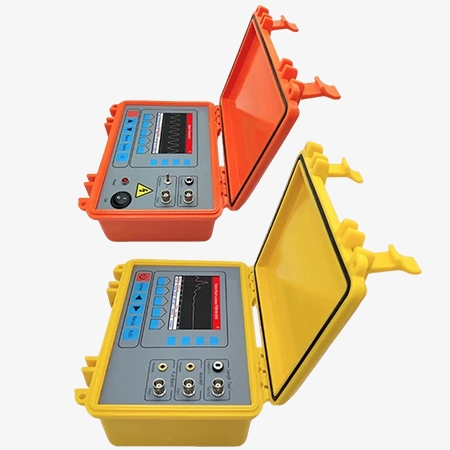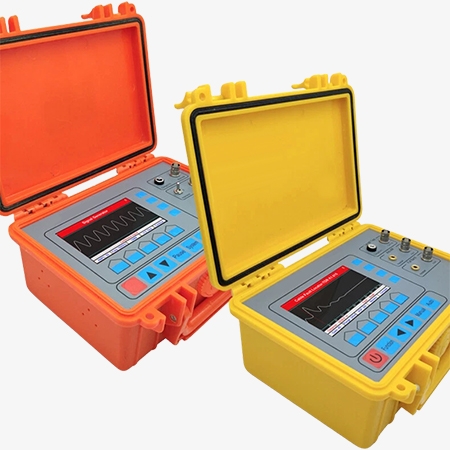The TDR Cable Fault Finder is a professional instrument for locating and detecting faults and paths in high- and low-voltage underground power cables. It boasts a simple circuit structure, high reliability, and a low false positive rate.

High-Precision Anti-Interference Leakage Locator
- The cable fault locating equipment's anti-interference channel is equipped with a high-performance filtering circuit to resist power frequency interference. Even in a power outage, when used with a signal generator, it can not only accurately locate the ground leakage location of directly buried cables, but also clearly detect the cable path and depth.
- A highlight of this instrument is its full-band channel design. Using a dedicated probe, it can detect minor ground leakage faults in directly buried low-voltage cables while the cables are energized. This not only minimizes the impact of power outages on user usage, but also promptly detects minor leakage problems in their early stages, preventing further escalation and reducing economic losses caused by downtime.
- The cable fault meter can detect ground leakage faults within the insulation resistance range of 0-0.5MΩ, covering most low-voltage cable leakage scenarios. With a test error of no more than 1 meter, it can pinpoint the fault location within a very small radius, significantly reducing on-site excavation verification efforts.

High-Performance Hardware and Long-Lasting Battery Life
- The TDR Fault Locator utilizes an ARM+FPGA architecture, ensuring fast and accurate waveform processing. It supports waveform comparison, making it easy to identify voltage decay faults caused by oxidation.
- The TDR cable fault finder features a large, 480 x 800 true-color display, ensuring clear visibility even in direct sunlight, and ensuring operators can accurately read test data and waveform information regardless of ambient light.
- The cable fault locator machine is equipped with a high-energy lithium battery, providing a runtime of 6-8 hours, meeting the demands of extended fieldwork and continuous testing, reducing charging times, and improving work efficiency.
Applications
The cable fault locator is suitable for multiple scenarios: troubleshooting high and low voltage cable faults in the power industry, testing communication cables in the communications industry, troubleshooting production cables in industrial enterprises, locating indoor cable problems in the civil construction field, and can also be used for cable fault detection in special environments such as ships, rail transit, mines and oil fields.

Railway

Shopping Mall

Industrial Park

Communications
| Model | SISCO-CFL-HMDL91 |
| Distance Test | |
| Test Range | 8000 meters (customizable) |
| Test Blind Zone | 0 meters |
| Test Resolution | Minimum 0.5 meters |
| Pulse Width | 96ns-10us automatic adjustment |
| Test Method | Automatic testing and manual analysis available |
| Comprehensive Tester for Leakage Current and Path Location | |
| Leakage Fault | Leakage insulation resistance range 0-0.5mΩ |
| Test Error | Not greater than 1 meter |
| Cable Depth | Not less than 3 meters |
| Detection Range | 8000 meters |
| Path Accuracy | Not greater than 0.2 meters |
| Signal Generator (True Color Display) | |
| Signal Output | 512kHz/1kHz adjustable |
| Device Dimensions | 220mm×160mm×90mm |
| Device Weight | 2kg |
Q1: How to Use a Cable Fault Locator?
A1: To use a cable fault locator, connect the instrument to the faulty cable, select a test mode (such as low-voltage pulse or high-voltage flashover), transmit a signal, analyze the reflected waveform, determine the distance to the fault, and then precisely locate the fault along the cable. After repair, retest to confirm the location.
Q2: How Does a Cable Fault Locator Work?
A2: Cable fault locators typically use technologies such as time domain reflectometry (TDR), bridge technology, and acoustic-magnetic synchronization. They are portable, easy to use, and offer high locating accuracy. They are widely used in cable maintenance and emergency repair in industries such as power, communications, railways, and petrochemicals, significantly improving troubleshooting efficiency and reducing power outage time and repair costs.
Q3: What Factors Affect the Test Accuracy of a Cable Fault Locator?
A3: The test accuracy of a cable fault locator is affected by a variety of factors, including cable length, type, installation environment, and connector quality; the instrument's sampling rate, pulse width, signal processing capabilities, operator experience, external electromagnetic interference, grounding conditions, and fault type (such as low-resistance, high-resistance, flashover, or broken wire). These factors together determine the accuracy and reliability of fault location.
Tips: What Role Does the TDR Function Play in a Cable Fault Locator?
The TDR (Time Domain Reflectometry) function in a cable fault locator primarily sends a specific electrical signal into the cable. It then receives the signal reflected back when it encounters impedance changes (such as cable breaks, short circuits, poor RJ45 connector contact, aging, and damage), and other faults. By combining the signal transmission speed and reflection time, it accurately calculates the distance from the fault point to the test end, allowing it to quickly locate various physical faults in the network cable, eliminating blind troubleshooting.
Thank you for buying industrial test and measurement equipment on SISCO.com, all products sold by SISCO and the partner cover a 12 months warranty, effective from the date of receiving the products.
What is covered?
SISCO is responsible for providing free spare parts, and free technical support to assist the customer to repair the defective products until the problem is solved.
What is not covered?
- Product purchased from anyone other than a SISCO store or a SISCO authorized reseller.
- Expendable parts.
- Routine cleaning or normal cosmetic and mechanical wear.
- Damage from misuse, abuse or neglect.
- Damage from use of parts other than SISCO approved.
- Damage from use outside the product’s usage or storage parameters.
- Damage from use of parts not sold by SISCO.
- Damage from modification or incorporation into other products.
- Damage from repair or replacement of warranted parts by a service provider other than a SISCO authorized service provider.
- Damage caused by the application environment not meeting the product usage requirements and the failure to perform preventive maintenance.

